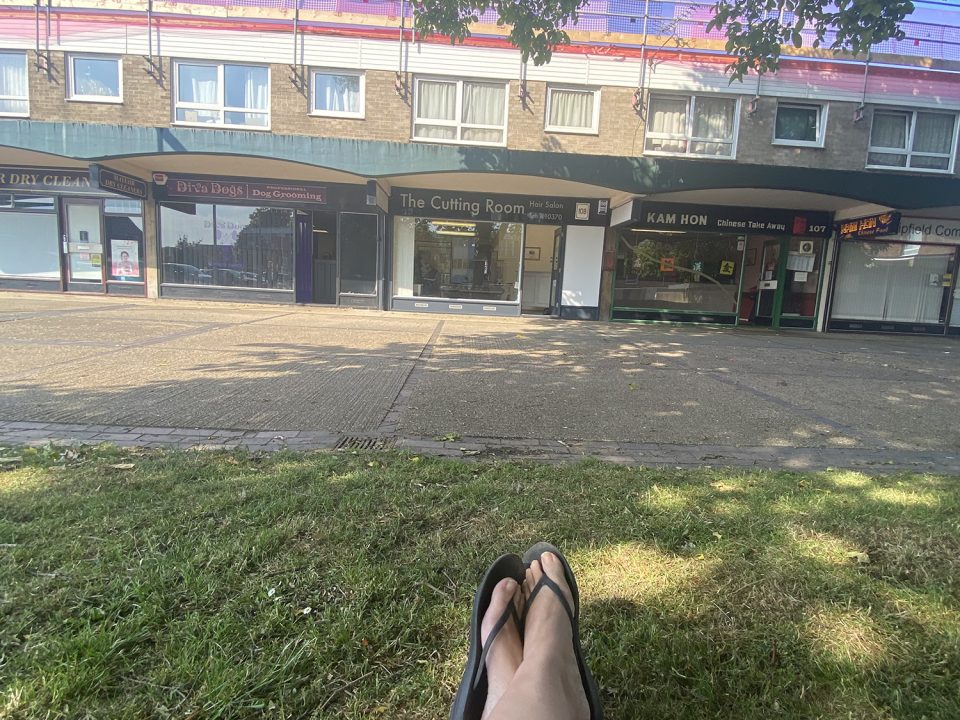
Where Do Your Outfits Start?
December 2, 2009Show Me Your Christmas Tree!
December 7, 2009This post starts with a story.
At the end of September I needed boots. I spent several hours wandering the shops with a fairly small budget of £30. I tried on every pair of boots I saw, including some I couldn’t afford until eventually deciding the style I liked best was these:

The were fairly simple, with a sturdy heel I could actually walk in, but I liked the buckle detailing and ruched ankle. Better still they cost just £14.99.
Now, I walk A LOT, so unsurprisingly I needed to get them re heeled at the end of October, just a month after buying them. So I popped into my friendly shoe repair place and paid them £7.50 to put new heels on.
I hoped the replacements would maybe be longer lasting than the uber cheap originals, but it was not to be. Now, at the beginning of December I find myself needing to re heel my boots once more, the soles are also wearing thin and could possibly do with replacing too at a total cost of somewhere around £11.
I, of course, now find myself in a position where I will have spent more than the boots cost in the space of 2 months to keep them wearable. The boots are now well worn of course, meaning there is the odd dent in the heel and small scuffs on the toes. This style is still available in the shops and it’s tempting to just buy another pair.
We all know disposable fashion is terribly wasteful and that we should be mending our clothes, saving up to buy better quality and recycling where we can. But at what point does this mending your wardrobe become economically unviable?
I try and live my life in as eco friendly a way as I can. I look into the ethics of most places I shop and I balance my budget with my ethics. But are low priced retailers to blame for forcing us into a situation where it’s economically better to throw clothes away than to repair them?

Essentially most retailers, no matter how ethical, have a vested interest in getting us to fork out for new items rather than repairing what we already have. It’s what the fashion industry thrives on, and with their lower price points budget retailers have even more of an interest in parting you with your hard earned cash on a regular basis. Unless they start encouraging shoppers to maintain their wardrobes the cycle of over consumption is essentially unbreakable.
Low cost retailers have sprung up across the nation to feed an insatiable appetite for fashion, but the industry that deals with repairing or making your own hasn’t met this challenge with it’s own prices. It’s impossible for me to make a dress from scratch for less than I could buy it, so why learn? And when dry cleaning your suede jacket costs nearly as much as it cost to buy, why bother?
Where is the shoe polish in Primark or the Wundaweb in Peacocks? Could Timpson team up with Shoe Zone to offer a discount on your first re heeling? Could Johnsons offer a free dry clean to Primark customers?
Shopping ethically and being eco aware is about more than making sure your chosen retailer isn’t using child labour or carrying out deforestation on a massive scale. It’s about being aware of the scale of your personal consumption of resources and seeking to reduce waste.
But is there any point throwing good money after bad?
Photo by bird_flew




19 Comments
i love your analysis & your story! but i don’t think that fast fashion retailers are to blame for the state of disposable fashion today, the consumer is. until consumers turn away en masse from said retailers and essentially put them out of business, nothing will change. that said, i agree with your analysis that service providers are sometimes as expensive as fast fashion is cheap! i love your idea that they should partner and provide free or discounted services to shoppers – but ultimately, it’s up to us to try and purchase the best product our money can buy (and then take care of it), from the (ethically) best companies we can.
fast fashion is more expensive than you realize, as you pointed out above, you can end up spending more on repairs or replacements than you would on one more expensive quality garment or pair of shoes, AND the business practices of many of these companies contribute to unfair wages and environmental degradation – not good for anyone….
Peldyn – Gosh, you are thrifty. That’s beyond my skills! I wonder why those skills are being lost? Is it schools or parents not passing them on. Maybe that’s where the blame lies?
Grechen – I see what you mean. But the incentive to turn away from them isn’t there as long as disposable fashion is so much more acessible. How can we encourage people to go without shoes till they can afford the more expensive alternative?
Truthfully, I refuse to buy clothing that is too cheaply made, meaning inferior materials and shoddy workmanship but I will buy inexpensive clothing. Of course I am lucky in that I had a mother and grandmother who were talented seamstresses who taught me the trade and I repair all my own clothing. I also found a fantastic cobbler that I take my shoes to for repairs. If an item of clothing is beyond repair I will often turn the materials in it, into something else. I abhor throwing anything away. If my shoes are too far gone I give them to my daughter who has started taking shoes apart and making new shoes out of them. I guess we are a thrifty bunch!
.-= Peldyn´s last blog ..Straw into Gold- To Dye For =-.
@retro chick – you’re absolutely right. disposable fashion is cheap and enticing, but i don’t think one needs to go without shoes necessarily, until they afford a higher quality shoe. we just need to understand and buy with full consciousness of what we are purchasing, and the real cost of it. and even if you have to go with cheaper shoes that may not be of higher quality, at least try to repair them – as you did – instead of just throwing them away and buying a new pair. get as much use out of them as you can….disposable fashion doesn’t HAVE to be disposable…
and ultimately, i think there is a place for “fast” and “disposable” fashion, i just don’t believe anyone should be filling their entire wardrobes with it…that’s where the troubles lie.
I love your analysis but I think it’s hard to turn away people from fast fashion because it’s extremely affordable. I do avoid buying shoes because I know they don’t last, on top of that the materials are cheap, they make my feet sweat and smell 🙁 Sorry that was gross. I try to buy vintage or seond hand clothing it’s great but I also mix it up with fast fashion, I usually pick pieces that look classy or can be mixed with several pieces, I have stuff from H&M that are 2 years old, same with U.S. forever 21. I respect your insights and loved reading your post 🙂
much love,
Glendy <3
Grechen – again good point! It’s about getting the best wear out of what you have, regardless of the price. But it would be nice if there was some encouragement from the shops themselves to do so!
Glendy – I do the same. Most of my wardrobe is vintage or second hand, but there are things you can’t buy second hand always! Shoes and underwear I find difficult now I’m on such a limited budget!
I saw the title of this post on my knockoff post and because I’m a sucker for economics I had to read!
What really hit home is this: “but the industry that deals with repairing or making your own hasn’t met this challenge with it’s own prices.”
I recently had a conversation with my dad on this topic. It’s true with any industry. Take television, for example. They used to be so expensive that when they broke, you would walk down to a TV repair place, buy another set of tubes, and fix them yourself – OR you would call the TV repair guy to come in and fix it (in college, he did TV repair).
Now, TV’s are so cheap, and the technology is such that if it’s broken, it’s going to cost 3 times as much to have it fixed, as it would cost to just buy a new one (considering the original amount you spent on the TV is a sunk cost, because it’s no longer a relevant cost to the repair of the TV – it wouldn’t change your course of action going forward, to repair the TV). It’s not like you can fix a lot of these hi-def screens yourself, either. We’ve become a consumable world, because the repair industries haven’t truly kept up with the prices of the items themselves. So the consumer does end up paying much more to have something repaired.
If there were more of a demand for the repair, the industry would thrive, but that’s quite the Catch-22.
Where clothing is concerned, I’m glad I learned to sew, and that my mom gave me a sewing machine as a graduation present. I can TRULY get the best wear for the price, but shoes are another story entirely.
.-= birdie´s last blog ..Wholestyle on the Web: Week of 12/04/2009 =-.
Birdie – That’s a very good point about TVs actually. Maybe it’s just the way things evolve and we have to live with it.
It seems to me like disposable electronics should change too. The world we live in now is so hyper aware of waste. If the repair industry stepped up to the plate they could clean up!
I think you make an excellent point about the repair inductries. I think this whole situation is a bit of a catch 22 – repair people can’t lower their prices because there’s not enough customers (which also keeps down competition, which would further lower prices) and there’s not more customers because prices are high and there isn’t very many shops.
About the making your own: I think crafty people don’t treat making your own as a money saving thing at all. For most people it’s a hobby, and people want lots of choice in fabrics/yarn/craft supplies because they do it for fun not functionality. This means craft shops have to carry lots of stock that very few people ever buy in the end, hence the prices.
I also don’t think making your own is necessarily environmentally friendly. If lots of people buy a sewing machine but don’t use them very often, what a waste of resources on producing all the thousands of sewing machines! It is much better for the environment to have a central bank of sewing machines (i.e. a factory) that get constantly used. I’m not saying you shouldn’t make your own (I do!), but I think the environmental benefit is usually vastly overstated.
.-= Franca´s last blog ..IFB Links à la Mode =-.
RE: Franca – Several craft/sewing supply places have closed recently in my area, and the price of sewing machines has gotten MUCH higher.
To change the system we would have to create a demand for repair instead of buying new. Disposable electronics will change when societal views on consumption change.
.-= birdie´s last blog ..Wholestyle on the Web: Week of 12/04/2009 =-.
I have to say that’s one area where I actually do okay – not buying and replacing. I fork out quite a bit for my clothes, etc. but I keep them forever. I don’t follow trends but rather buy what’s ‘me’ with the intention that I will wear it indefinitely. And I actually do! Also, I don’t own many shoes and boots but buy styles that will go with just about anything, I hate having things sit there and not be used.
However, I still think I should buy more vintage than new clothes. There is always room for improvement!
.-= Denise @ Swelle´s last blog ..How to Have a Houndstooth Holiday =-.
Hi! I thought about this issue already a long time ago. My conclusion: I save up to buy shoes that are rather long-lasting (depending if you need them daily or only for party occasions) and I often do DIY/vintage/reparing for my clothes. I hate how many companys produce such bad quality that you are only able to wear their products once or twice.
Lilly
.-= Lilly´s last blog ..New trend: Introducing the Piano Style =-.
This is a big part of why I mainly focus on second-hand or hand-made items. When I buy new items, I will save up and buy the best quality possible. I don’t end up with as many new clothes as someone who shops somewhere like Old Navy, but what I buy will far outlast theirs.
I guess my philosophy is Buy Better, Buy Less. Most people have more clothes than they really need anyhow.
The repair industry hasn’t just fallen behind in terms of pricing, it’s also a dying industry. The past few times I’ve had to re-sole my shoes, I’ve always brought them in to cobblers who were middle-aged men or older and look like they’re on the verge of retiring. Who will do shoe repairs when they do? It’s almost as though cobbling is a lost art because our generation has grown up with this world where so many things are semi-disposable.
I think one of the things that exacerbates our appetite for fast fashion is our appetite for variety and abundance. It’s tempting to buy several pairs of inexpensive boots in different styles rather than invest in one quality pair. Buying for quality forces us to be more thoughtful about what we purchase and how it’ll be used and worn, and forces us to make choices.
.-= lisa´s last blog ..Luxe Or Less Gift Guide: Makeup Palettes =-.
Such a great post. I do feel that if you buy something from a lower end store, you can “splurge” on the maintenance. Even if you have to get them reheeled and resoled, it’ll still be cheaper than buying a $300 pair that probably would have to be resoled and reheeled at some point in the future…maybe.
Hmmm…I find it’s better to just buy well made things the first time.
Speaking of…I hope this is all right…there’s a lingerie giveaway contest happening at the blog and I’d be delighted if you enter! 🙂
http://stockingsaddict.blogspot.com
Speak it sister! I totally agree with you on this idea of disposable fashion. I tend to purchase things at thrift stores though in an effort to avoid cheaply made items. I have this pair of Nine West cowboy boots that I got 3 years ago at a thrift store in Pittsburgh, and they are just now getting to be unwearable. But I’ve also bought shoes at like a Charlotte Russe and even payless and they don’t even last a couple months. Pretty shitty even if I just spend 20 bucks. I have learned that for boots I always wear I need to just shell out a little more cash. Its inevitable.
Great post!
Fashion X K8.blogspot.com
.-= K8´s last blog ..Links a La Mode =-.
I have a saying that goes like this – one may buy underwear cheaply but don’t buy cheap underwear. It applies to almost everything. Shoes are something you definitely don’t want to skimp on, especially if you know you will wear them a lot. There are many great deals to be had. You should try ebay, even for new shoes. Also buying secondhand boots isn’t bad, it’s most likely they were worn with socks and you will wear yours with socks too so it should be alright.
.-= erika´s last blog ..Target Pop-Up San Francisco =-.
Love this post. So true. I always want to ‘make do and mend’ but like you say, it is often tempting to just buy anohter pair! I’ve even been tempted recently to just pick up two pairs to begin with! But I haven’t succumbed just yet!
.-= Emily´s last blog ..Derelict buildings =-.